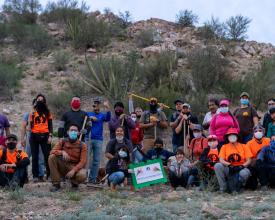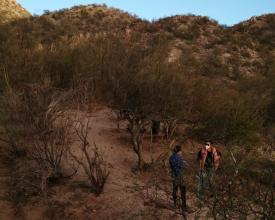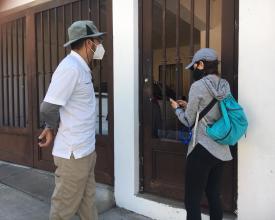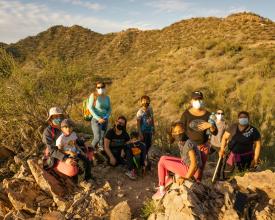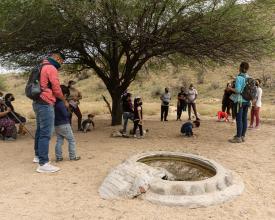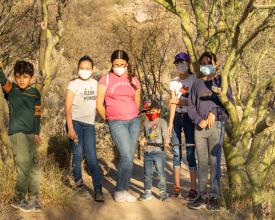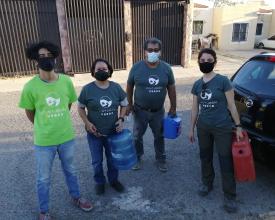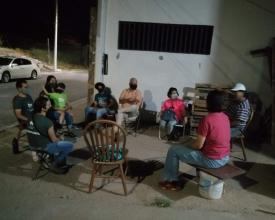
Community participation and co-responsibility for the creation and management of the "Green Belt Linear Trail".

Project aimed at promoting the co-responsibility of the citizens of Hermosillo, Sonora for the construction of the "Green Belt" Linear Trail, which delimits the buffer zone between the Urban Development and an ecological conservation area in a peri-urban arid zone.
A communication and environmental education campaign was implemented to publicize the project and encourage social participation and the creation of neighborhood committees to co-manage the trail.
In addition, this project seeks to increase well-being through contact with nature and provide a safer environment, preserving the natural environment and easy access for families.
Context
Challenges addressed
- Environmental challenges: Loss of biodiversity, drought, wildfires, solid waste pollution, heat islands, deforestation.
- Social challenges: Lack of social cohesion, stress, lack of spaces for leisure and recreation, health problems: respiratory and obesity, social insecurity, conflicting land uses-cumulative impacts, informal settlements.
- Economic challenges: Lack of access to long-term financing.
Location
Process
Summary of the process
These strategies intersect to carry out the participation process in a gradual and scalable manner.
Each one provides the basis for the next which allows for enriching the information and making more appropriate decisions for the project but also, stepping back to identify the most pertinent actions in subsequent steps.
Building Blocks
Measurement of social and governance indicators, and identification of key stakeholders.
The purpose of this strategy is to obtain data to establish a baseline. It was carried out through the application of surveys on social and governance indicators to residents of the intervention zone (neighborhoods adjacent to the Green Belt) as well as interviews with identified leaders and other key actors.
Enabling factors
- Design a measurement instrument to obtain relevant qualitative and quantitative information on the psychological and demographic characteristics of the audience.
- Access to the target population.
Lesson learned
Sampling can be a very valuable tool, however, it can be more time consuming than it is worth.
As a first enclosure with neighbors, it is a good strategy for building a relationship of trust when conducted with empathy and skill.
Resources
Analysis of motivators and detractors
This strategy made it possible to identify the relevant characteristics of the target audience for the communication campaign, as well as the elements that maintain the problem situation: personal characteristics of the residents, external factors related to the context and locality, and the motivators that facilitate actions to identify how to motivate people to change their behavior or perceptions related to the problem.
Enabling factors
- People's willingness to answer the surveys.
- Information from key people that allowed us to identify with greater precision the relevant characteristics of the audience.
Lesson learned
External detractors are difficult to overcome, since they respond to situations associated with government management, institutions and difficulty in accessing necessary resources such as infrastructure, efficient public services, coordinated response of government agencies, among others, which make it difficult to maintain people's motivation.
Resources
Stakeholder Mapping - Spheres of Influence
The purpose of this strategy is to identify the actors who have some degree of influence over the target audience, how they influence, i.e., what role they play in that interaction as well as the level of this influence and how this influence can be used to contribute to audience behavior change that will contribute to the solution.
Enabling factors
- Analysis of the information obtained in the surveys and interviews.
- Obtaining information directly from relevant stakeholders.
- Establishment of a bond of trust to facilitate the collection of information.
Lesson learned
A proper analysis allows for effective influence through key actors; however, there may be actors whose level of influence is not direct or high but is significant, as in the case of laws and government institutions.
Resources
Environmental education interpretive walks
Family interpretive walks were conducted, some exclusively for residents of the intervention area and others open to the general public with the objective of creating bonds and strengthening social ties with trail users as well as offering opportunities for guided experiences in nature while raising awareness of the Greenbelt Project and inviting people to participate in the trail construction activities.
They were implemented on a weekly basis managing prior registration, data collection with prior consent, with limited number of attendees due to the contingency and with the management of the following topics relevant to the project objectives:
- What is a Natural Protected Area and in the specific case, Johnson Park.
- What is the Green Belt Project.
- What is the invasive buffel grass and its impact as an invasive plant in the desert ecosystem.
- Native flora and fauna in the Green Belt and Johnson Park.
- Restoration actions in natural areas: Johnson Park.
- Tips on how to do outdoor activities without leaving a trace.
Enabling factors
- Use of key messages in the calls to the walks.
- Social recognition of the association.
- Activity planned and conducted under an informative approach, creating an atmosphere of empathy, awareness and respect.
Lesson learned
Carrying out recreational activities in natural areas with educational themes is a very effective tool for transmitting the message of the importance of conserving natural areas and their relationship with people's wellbeing, with children being a group identified for better formal and structured follow-up.
Neighborhood committee and volunteer group
The purpose of this strategy is to build ties between neighbors and volunteers interested in participating in the construction, management and maintenance activities of the linear greenbelt trail and associated areas.
Meetings and fellowship opportunities were held to share ideas as well as information on:
- Procedures for reporting environmental incidents in the area.
- Techniques for reforestation and pruning of native plants.
- Characteristics and importance of native plants in the region.
Neighbors were invited to form a group through whatsapp to keep them informed and invite them to activities.
Enabling factors
- Social recognition of the association.
- Linkage with other sectors and relevant social actors.
- Empathy towards the problems expressed by the neighbors.
- Encouragement of participation and involvement in decision making.
Lesson learned
- For residents, involvement in the project implies time away from home and work complications (one of the main reasons for non-attendance at events that we detected both in the surveys and in maintaining attendance at activities).
- More urgent needs were detected and closer to their homes than the Green Belt (vacant lots / clandestine dumps in front of homes).
- For an effective follow-up, it is suggested to implement programs through focus groups in the already established groups and in other sectored populations with specific objectives: children, women, housewives, youth.
- Improve communication, coordination and dialogue between local and regional actors and authorities for coordinated and efficient action.
Impacts
-
Increased outreach of the Green Belt project resulting in an increase in the number of neighbors involved in the management, construction and care of the trail.
-
Fostering of environmental identity and sense of belonging in the people involved through participation in the construction of the trail and in interpretive walks.
-
Opportunity of a space that represents an option for physical activation and sports as well as healthy recreation for the inhabitants of the area.
-
Opportunities for education and experiences in green spaces that favored the social fabric and cohesion of the neighborhood by creating bonds through collaborative activities in the construction of the trail and cleaning of the area, integrating diverse population groups.
-
Incorporation of the importance of natural areas for biodiversity conservation and climate change in their environmental perception.
-
Generation of a model of social participation that served as an inspiration and guide for other actors in different sectors of the city.
Beneficiaries
- Residents of the neighborhood adjacent to the Green Belt, Colonia Los Angeles.
- Citizens of the city of Hermosillo who need natural spaces, green areas and accessible outdoor areas for leisure and recreation.
Sustainable Development Goals
Story
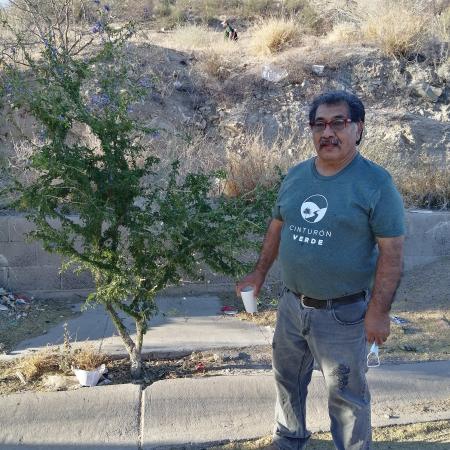
"He who is willing does more than he who is able".
Don Sebastian is one of the neighbors most appreciated by the volunteers and the other members of the committee, since the first day he was invited to the activities he has attended consistently, with an excellent mood and a great disposition being the guardian of the native trees that were planted in front of his home.
He shares these activities with his granddaughter Isabela, 12 years old, since Don Sebas at 65 years old and with a leg problem that prevents him from walking well and climbing hills, maintains the hope of recovering this space, he gets excited whenever he sees a group of walkers passing through the trail and is waiting for the next activity, he is a great example to follow and a committed volunteer and appreciated by all.

